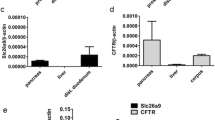Abstract.
Submucosal glands (SMG) are important secretory glands that are present in the major airways and bronchioles of humans. In mice the structure, cellular composition, and density of SMG are similar to those seen in humans, but the glands are present only in the trachea. Characterization of SMG is important as they secrete bacteriocidal products such as lactoferrin, lysozyme, and defensins believed to be of importance in the innate defense system. Serous cells in SMG are the primary site of cystic fibrosis transmembrane conductance regulator (CFTR) gene expression and the initial site of histological abnormality in cystic fibrosis (CF) individuals. In this study, we examined four inbred strains of mice (A/J, C57BL/6N, FVB/N, and BALB/CAnN) and revealed that the extent to which glands descend in the mouse trachea varied between inbred strains. In particular, the A/J and C57BL/6N strains exhibited few SMG extending further than the first or second intercartilaginous space (mean depth of 0.4 ± 0.11 and 1.5 ± 0.32 tracheal rings respectively) in the trachea, whereas the FVB/N and BALB/CAnN strains had SMG extending beyond the fourth space (mean depths of 3.3 ± 0.46 and 5.6 ± 0.45 rings respectively). We have previously shown that in congenic C57Bl/6N Cftr mutant mice (CF mice), the SMG are distributed more distally than in wild-type C57Bl/6N but are indistinguishable from BALB/CAnN wild-type or CF mice. The implication that SMG distribution is influenced by Cftr gene expression (or a gene closely linked to Cftr) led us to investigate the genetic difference between C57Bl6/N and BALB/CAnN mice. In recombinant inbred strain (RIS) analysis (with BALB/CJ and C57BL/6J progenitors), two loci were identified as being linked to the SMG phenotype (peak likelihood statistic levels of 8.8 and 9.9 on Chrs 9 and 10 respectively, indicating suggestive linkage). A subsequent segregation analysis of an F2 intercross between the C57BL/6N and BALB/CAnN mice indicated that there were at least two major genetic factors responsible for SMG distribution. The loci indicated in the RI analysis were included in a targeted genome scan involving 235 F2 intercross animals (C57BL/6N and BALB/CAnN strain intercross). The genome scan confirmed the locus on Chr 9 (between genetic markers D9Mit11 and D9Mit182), designated Smgd1, as significantly linked to the SMG distribution phenotype (peak LOD score 5.8) within a 95% confidence interval of 12 cM.
Similar content being viewed by others
Author information
Authors and Affiliations
Additional information
Received: 26 June 2000 / Accepted: 18 September 2000
Rights and permissions
About this article
Cite this article
Innes, B., Dorin, J. Submucosal gland distribution in the mouse has a genetic determination localized on Chromosome 9. 12, 124–128 (2001). https://doi.org/10.1007/s003350010244
Issue Date:
DOI: https://doi.org/10.1007/s003350010244




